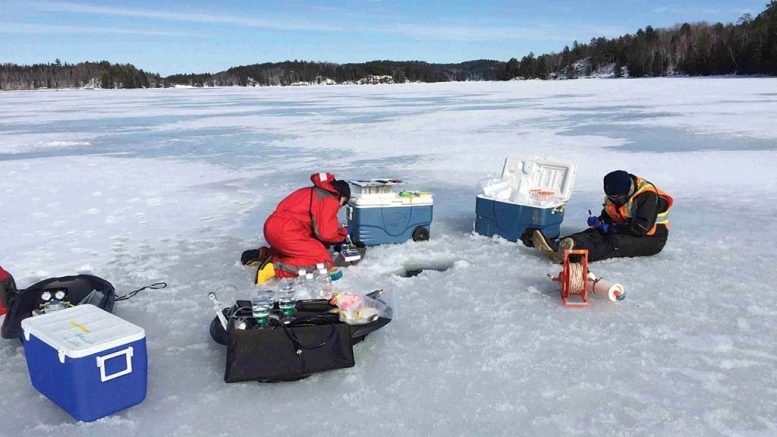Bioremediation became a buzzword for the Canadian mining industry in the 1970s and ’80s. Today, researchers at the University of Toronto’s Lassonde Institute of Mining are coming up with the next generation of strategies to treat mining wastewater using biological methods. They are making use of genomics and modelling to develop new biologically informed, and more sustainable and economical strategies.
“The mining industry in Canada withdraws one billion cubic metres of water every year and up until now, companies have had to rely on chemical approaches to manage their wastewaters to prevent possible environmental impacts,” says Lesley Warren, an aqueous and microbial geochemist and professor with the Lassonde Institute of Mining. “We know that bacteria are present throughout all mining water systems, but we don’t fully understand the positive or negative impacts they can have on water quality.”
By understanding how naturally occurring bacteria within these mining water systems are influencing chemical reactions, biologically informed proactive treatment strategies can be developed — with game-changing potential to prevent problems, decrease chemical loads and lower environmental impacts.
While Canadian mining operates under some of the most stringent effluent quality guidelines worldwide, the industry continues to look for innovative ways to improve the sustainability of operations.
Currently, no biological standards exist, limiting the mining sector’s ability to design new water management and treatment methods, which take advantage of the naturally occurring bacteria within the water systems.
A cornerstone of Warren’s research is metagenomics — the genetic characterization of microbial communities. Her work is opening the microbial black box for the industry by combining this powerful approach with more comprehensive geochemical characterization.
“Metagenomics holds the key to developing innovative biological strategies, allowing us to work towards a more environmentally friendly approach to monitoring, managing and treating mining wastewater,” Warren says.
Warren works to determine the identities and roles of microbes involved in geochemical reactions occurring within these waters to gain an understanding of the bacteria’s beneficial — and detrimental — processes and develop tools that will help the industry better steward the water it uses and decrease the risk of potential negative environmental impacts such as acidity, metal contaminants and oxygen consumption.
With mines becoming larger in scale to compensate for lower-grade ores, ever more water is needed to maintain profitability, highlighting the need for more sustainable approaches. Indeed, the industry is focused on minimizing water requirements, while increasing the yield of recoverable minerals, to be socially and fiscally responsible. The sector has made great strides toward minimizing its effects on water quality and waste through environmental management strategies, monitoring discharges and recycling used water. However, water pollution remains a concern.
“Acid rock or mine drainage (ARD/AMD) is the number-one priority pollution issue for the mining industry on a global scale, despite the recognition over a hundred years ago that AMD was caused by bacterial catalysis of reactions involving sulphide minerals — common components of metal ores — exposed to water and air,” Warren notes.

Geochemist and professor Lesley Warren (right) collects water samples for geochemical analyses from a waste deposit undergoing reclamation in Alberta. Credit: Lassonde Mining Institute.
Global Capital Magazine reported in 2008 that over 70% of the world’s mines were still at risk of developing AMD. Sulphuric acid lowers the pH of water, which increases their dissolved metal content. Both of these impacts can affect receiving ecosystem fauna. Treatment can be costly and challenging, underscoring why the risk remains.
“Until recently, we lacked the technologies to investigate these bacteria and identify the controlling factors affecting when such negative processes initiate,” Warren says.
Warren has been a leader in developing approaches to combine metagenomics with geochemistry to reveal the biological and geochemical levers involved in such processes, which can be used to develop monitoring tools, management and treatment strategies to help improve the mining industry’s sustainable water use.
Partnerships & innovation
Improvements in genomic sequencing technologies over the past few years have lowered the cost of performing research while increasing power and accuracy.
Warren works with companies and organizations that operate in the oilsands and base metal industries. By working across both resource sectors, her research can provide a more comprehensive picture of novel bacterial opportunities that can be applied to wastewater, closure, bioprocessing and heap-leach contexts.
By working in partnership with industry early adopters, such as Glencore (LON: GLEN) in Sudbury; Hudbay Minerals (TSX: HBM; NYSE: HBM) in Flin Flon, Man.; Rambler Metals & Mining (TSXV: RAB) in Baie Verte, Nfld.; and Syncrude in Fort McMurray, Warren’s innovative research is ensuring that research outcomes are widely relevant and benefit the mining industry.
“Through my conversations with corporate partners and the Mining Association of Canada and the Ontario Mining Association, there is a clear message that there is a need for smarter strategies,” Warren says. “Clear deliverables, measurable results and a realistic transfer of knowledge from the lab to active mining operations are equally important to the mining boardrooms of Canada.”
Fiscal & social responsibility
In an economy where prices are volatile, fiscal responsibility informs many strategic decisions. Warren’s research has potential to address the “bottom line,” along with the social responsibility and pressure of activist and community groups.
“There is a real responsibility for companies to work with communities to plan the environmental impact of any operation,” Warren notes. “Using genomic insights to more robustly plan remediation, mine-closure strategies and emergency operations, companies will be able to provide a proactive, practical and sustainable plan to stakeholders and regulators.”
Using the tools and lessons from integrating bacterial genomic understandings into proactive waste and wastewater management, mining companies will lower chemical loads and energy consumption, while improving water use. Less water use and greater efficiency are more sustainable, allowing companies to earn social consent and acceptance to operate.
In an era where the social licence for mining operations is increasingly considered as important — if not more important — than governmental permits, acceptance by stakeholders like indigenous peoples and non-governmental organizations decreases liability and risk, which contributes to higher profit margins.
The success of Warren’s research highly relies on working with a growing number of industry and community partners.
“Industry collaboration is essential to the success of our research. These collaborations enable critical input that informs and refines the research so that we can establish relevant understanding of the mining microbiome, ensuring effective communication and translation of the findings,” Warren says. “Once we understand these fundamentals, we’ll be able to give guidance that would apply to the whole industry and later develop site-specific, tailored solutions.”
The future of metagenomics in mining
When asked about the impacts of her research, Warren says that in five years, there will be strategies that embrace the biological opportunities that exist within mining wastes and waters, resulting in better water monitoring and management tools. Within 10 years, site-specific applications would roll out, along with large-scale pilot testing for implementation.
And 50 years from now? Warren sees an industry that is adaptive and flexible in its operations, resulting in mines that are better stewards of the land they work on, working alongside communities to ensure sustainable operations, which helps the environment.
— Keenan Marie Dixon is the communications coordinator at the Lassonde Institute of Mining. Created in 2001, the Lassonde Institute of Mining at the University of Toronto is an international centre for excellence in mining engineering. Its research crosses traditional disciplinary boundaries, examining the fields of mineral, civil, chemical and materials engineering alongside geological and environmental science and industry. Please visit www.lassondeinstitute.utoronto.ca for more information.





Be the first to comment on "Could microbes hold the key to more environmentally friendly mines?"